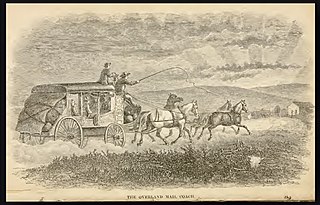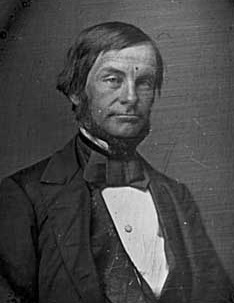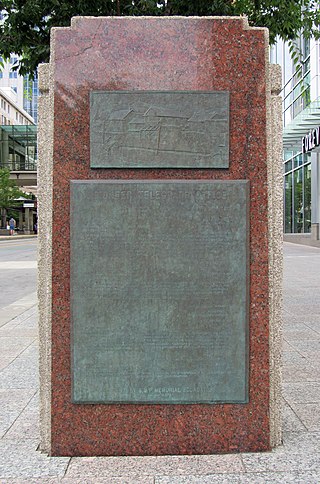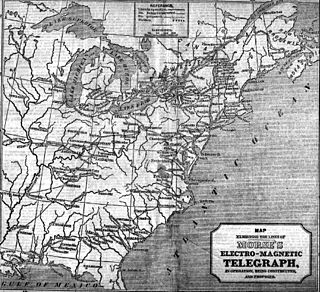Related Research Articles

The Pony Express was an American express mail service that used relays of horse-mounted riders. It operated from April 3, 1860, to October 26, 1861, between Missouri and California. It was operated by the Central Overland California and Pikes Peak Express Company.

Interstate 80 (I-80) is an east–west transcontinental freeway that crosses the United States from downtown San Francisco, California, to Teaneck, New Jersey, in the New York metropolitan area. The highway was designated in 1956 as one of the original routes of the Interstate Highway System; its final segment was opened in 1986. The second-longest Interstate Highway in the United States after I-90, it runs through many major cities, including Oakland, Sacramento, Reno, Salt Lake City, Omaha, Des Moines, and Toledo and passes within 10 miles (16 km) of Chicago, Cleveland, and New York City.

Stoystown is a borough in Somerset County, Pennsylvania, United States. It is part of the Johnstown, Pennsylvania, Metropolitan Statistical Area. The population was 300 at the 2020 census. Stoystown is located south-southeast of Johnstown and northeast of Somerset.

The California Zephyr was a passenger train that ran between Chicago, Illinois and Oakland, California via Omaha, Denver, Salt Lake City, Winnemucca, Oroville and Pleasanton. It was operated by the Chicago, Burlington & Quincy (CB&Q), Denver & Rio Grande Western (D&RGW) and Western Pacific (WP) railroads, all of which dubbed it "the most talked about train in America" on March 19, 1949, with the first departure the following day. The train was scheduled to pass through the most spectacular scenery on its route in the daylight. The original train ceased operation in 1970, though the D&RGW continued to operate its own passenger service, the Rio Grande Zephyr, between Salt Lake City and Denver, using the original equipment until 1983. In 1983 a second iteration of the California Zephyr, an Amtrak service, was formed. The current version of the California Zephyr operates partially over the route of the original Zephyr and partially over the route of its former rival, the City of San Francisco.

The California Trail was an emigrant trail of about 1,600 mi (2,600 km) across the western half of the North American continent from Missouri River towns to what is now the state of California. After it was established, the first half of the California Trail followed the same corridor of networked river valley trails as the Oregon Trail and the Mormon Trail, namely the valleys of the Platte, North Platte, and Sweetwater rivers to Wyoming. The trail has several splits and cutoffs for alternative routes around major landforms and to different destinations, with a combined length of over 5,000 mi (8,000 km).

Butterfield Overland Mail was a stagecoach service in the United States operating from 1858 to 1861. It carried passengers and U.S. Mail from two eastern termini, Memphis, Tennessee, and St. Louis, Missouri, to San Francisco, California. The routes from each eastern terminus met at Fort Smith, Arkansas, and then continued through Indian Territory (Oklahoma), Texas, New Mexico, Arizona, Mexico, and California ending in San Francisco. On March 3, 1857, Congress authorized the U.S. postmaster general, at that time Aaron V. Brown, to contract for delivery of the U.S. mail from St. Louis to San Francisco. Prior to this, U.S. Mail bound for the Far West had been delivered by the San Antonio and San Diego Mail Line since June 1857.

The Central Overland California and Pike's Peak Express Company was a stagecoach line that operated in the American West in the early 1860s, but it is most well known as the parent company of the Pony Express. It was formed as a subsidiary of the freighting company Russell, Majors, and Waddell, after the latter two partners bought out Russell's stage line, the Leavenworth and Pikes Peak Express Company. The stage line had made its first journey from Westport, Missouri, to Denver on March 9, 1859.
Benjamin Franklin Ficklin (1827–1871) was a soldier, adventurer, and entrepreneur known for his help in starting the Pony Express and for establishing other stage coach and mail routes in the United States during the nineteenth century. Ficklin was also one of the people responsible for the creation of the Pacific Telegraph Company in 1861.

William Hepburn Russell (1812–1872) was a United States businessman. He was a partner, along with Alexander Majors and William B. Waddell, in the freighting firm Russell, Majors, and Waddell and the stagecoach company the Central Overland California and Pikes Peak Express Company which was the parent company of the Pony Express. His public life is one of numerous business ventures, some successful and some failed. While Russell, described as a good-looking man, lived the majority of his life on the edge on the western frontier, he was always more at home in the upper-class settings of the East coast.

Alexander Majors was an American businessman, who along with William Hepburn Russell and William B. Waddell founded the Pony Express, based in St. Joseph, Missouri. This was one of the westernmost points east of the Missouri River from its upper portion beyond that state. It was a major supply point for migrants and pioneers headed west to Oregon Country.

U.S. Route 50 (US 50) is a transcontinental highway in the United States, stretching from West Sacramento, California, in the west to Ocean City, Maryland, on the east coast. The Nevada portion crosses the center of the state and was named "The Loneliest Road in America" by Life magazine in July 1986. The name was intended as a pejorative, but Nevada officials seized it as a marketing slogan. The name originates from large desolate areas traversed by the route, with few or no signs of civilization. The highway crosses several large desert valleys separated by numerous mountain ranges towering over the valley floors, in what is known as the Basin and Range province of the Great Basin.

Ruby Valley is a large basin located in south-central Elko and northern White Pine counties in the northeastern section of the state of Nevada in the western United States. From Secret Pass it runs south-southwest for approximately 60 miles (96 km) to Overland Pass. To the west is the steep escarpment of the Ruby Mountains, and to the north is the East Humboldt Range and Clover Valley. The east side of the valley is less well defined, but its maximum width is about 10 miles (16 km) near Franklin Lake. At its south end lies the Ruby Lake National Wildlife Refuge.
The Central Overland Route was a transportation route from Salt Lake City, Utah south of the Great Salt Lake through the mountains of central Nevada to Carson City, Nevada. For a decade after 1859, until the first Transcontinental Railroad was completed in 1869, it served a vital role in the transport of emigrants, mail, freight, and passengers between California, Nevada, and Utah.

James Hervey Simpson (1813–1883) was an officer in the U.S. Army and a member of the United States Corps of Topographical Engineers.

The first transcontinental telegraph was a line that connected the existing telegraph network in the eastern United States to a small network in California, by means of a link between Omaha, Nebraska and Carson City, Nevada, via Salt Lake City. It was a milestone in electrical engineering and in the formation of the United States of America. It served as the only method of near-instantaneous communication between the east and west coasts during the 1860s. For comparison, in 1841, the news of the death of President William Henry Harrison had taken 110 days to reach Los Angeles.

Alexander Toponce was an American pioneer in the Intermountain West region of the United States. His family immigrated to the United States from Belfort, France when he was seven and Alexander left home about three years later. He worked as a laborer for several years, mostly in the logging and lumber business, before becoming a teamster, stagecoach driver and freight handler. Toponce headed west when he was about fifteen years old, first to Missouri and then to the northern Intermountain West. There, he ran freight and stagecoach outfits, owned livestock herds, sometimes tried his hand at mining, and invested in all manner of development projects. He is credited with opening or improving many early freight and stage routes throughout the region. Later in life, he mostly invested in mining properties while holding interests in land development companies. Over his lifetime, Toponce made and lost several fortunes, the result of bad weather, Indian raids, unpredictable prices and dishonest partners.
The Overland Trail was a stagecoach and wagon trail in the American West during the 19th century. While portions of the route had been used by explorers and trappers since the 1820s, the Overland Trail was most heavily used in the 1860s as a route alternative to the Oregon, California, and Mormon trails through central Wyoming. The Overland Trail was famously used by the Overland Stage Company owned by Ben Holladay to run mail and passengers to Salt Lake City, Utah, via stagecoaches in the early 1860s. Starting from Atchison, Kansas, the trail descended into Colorado before looping back up to southern Wyoming and rejoining the Oregon Trail at Fort Bridger. The stage line operated until 1869 when the completion of the First transcontinental railroad eliminated the need for mail service via stagecoach.
Simpson Springs is a spring, former Pony Express station, former Civilian Conservation Corps camp, and campground in southeast Tooele County, Utah, United States.

The timeline of North American telegraphy is a chronology of notable events in the history of electric telegraphy in the United States and Canada, including the rapid spread of telegraphic communications starting from 1844 and completion of the first transcontinental telegraph line in 1861.
Jacobsville is a ghost town located in Lander County, Nevada, six miles west of Austin, on the east bank of Reese River, 0.7 mi N of US 50. Jacobsville was also known as Jacobs Spring, Jacobsville Station, Reese River and Reese River Station.
References
- ↑ Chapman, Arthur, The Pony Express (1932, A. L. Burt Co., Chicago). The attacks began near the St. Mary's River, in what is now western Nevada. There were two attacks; the first was rebuffed but the second, occurring a good deal east of the first, killed the four men and wounded Woodward. The wounded man escaped with two animals. His body was found in April 1852 near Deep Creek, some 300 miles from the attack site.
- ↑ Bancroft, Hubert Howe; Victor, Frances Fuller (1890). History of Nevada, Colorado, and Wyoming, 1540-1888. p. 226. Retrieved February 12, 2020.
- Nevada's Northeast Frontier, by Eda Patterson, Louise Ulph, and Victor Goodwin (1969), ISBN 978-0-87417-171-6
- Dictionary of American Biography, vol. II, p. 91
- The Man from Somerset, by Frank Winslow (1993), ISBN 978-0-533-10560-1. A semi-fictional account of the life of George Chorpenning.
- The Overland Mail 1849-69, by Leroy R. Hafen (1929). A detailed account of the various mail lines.